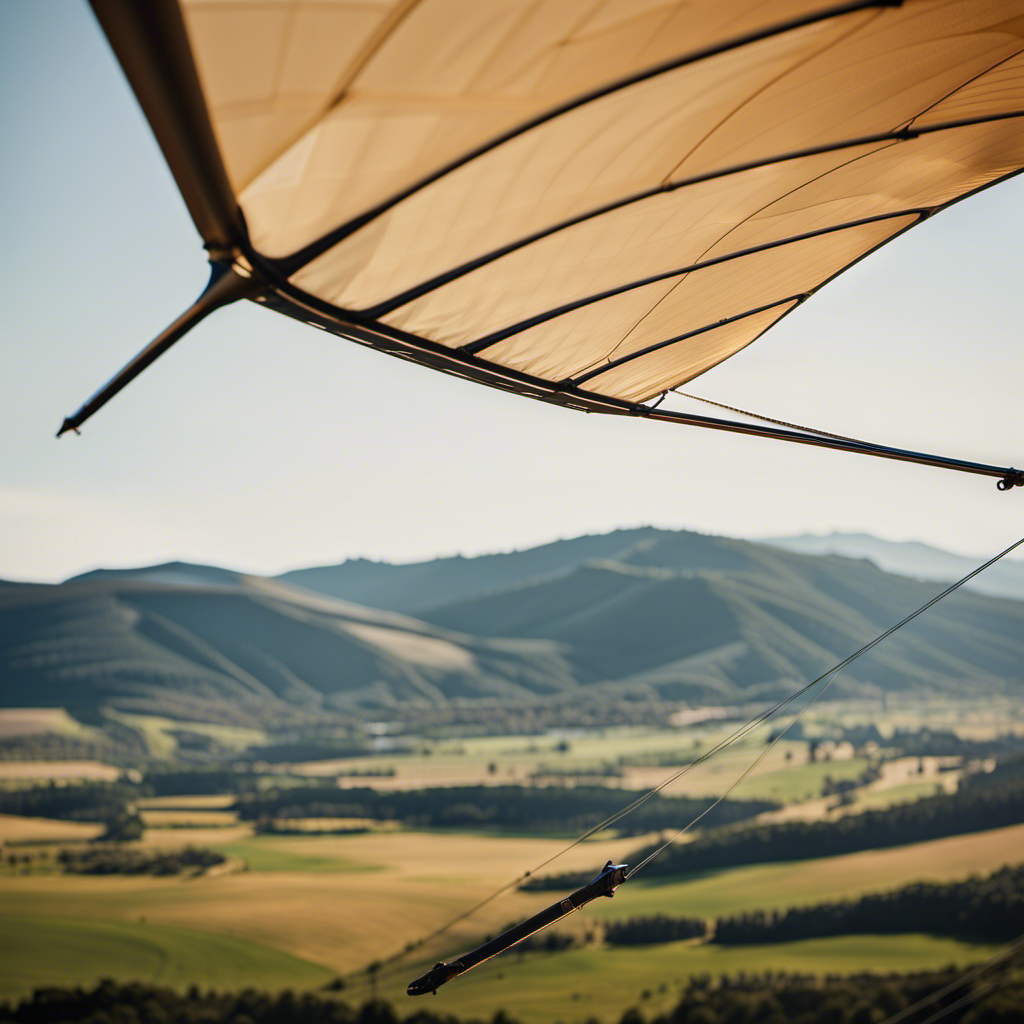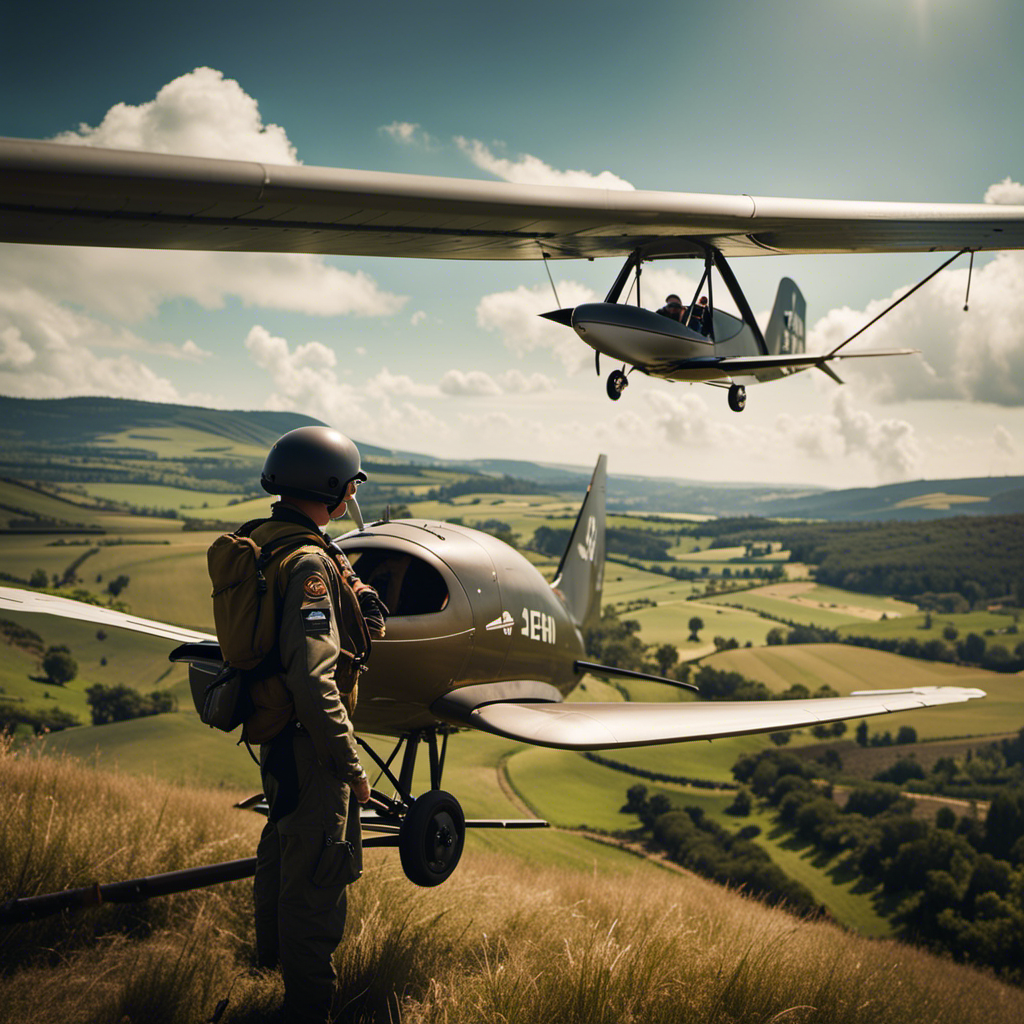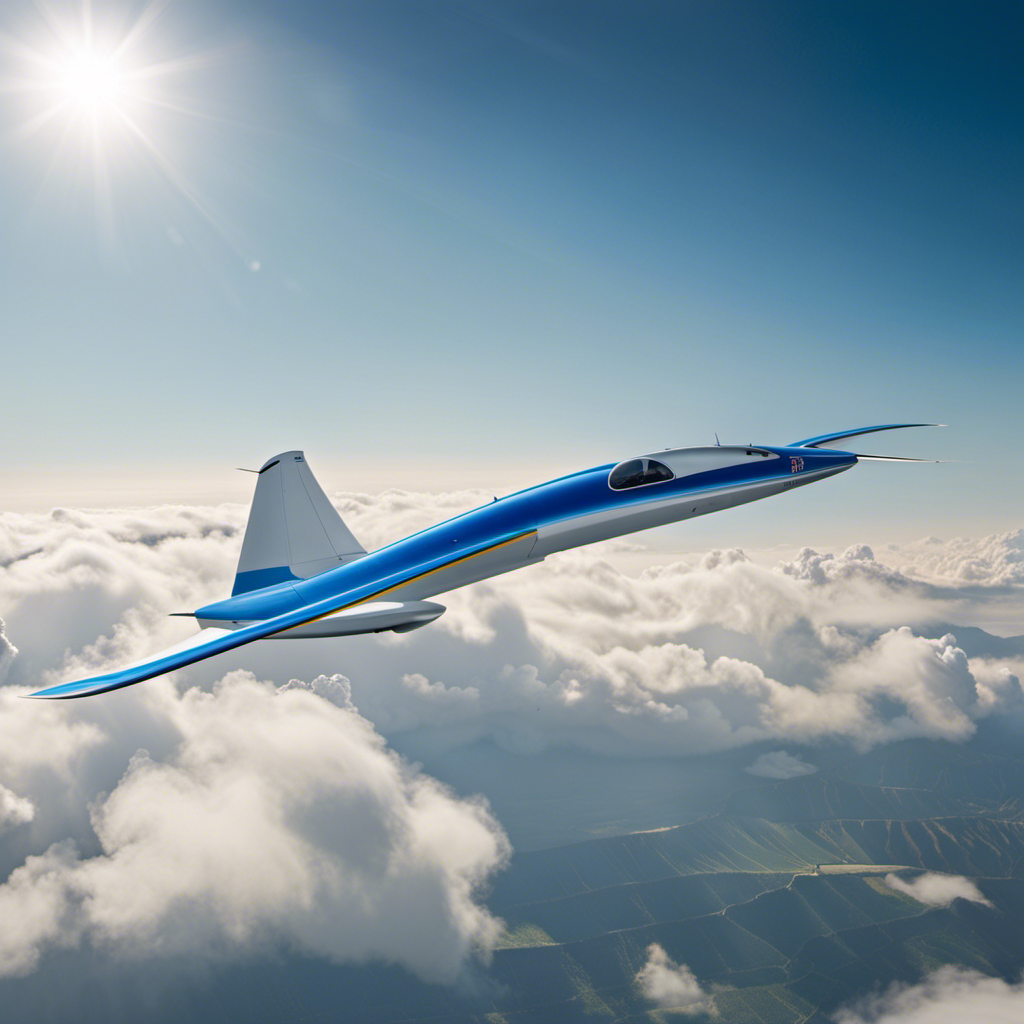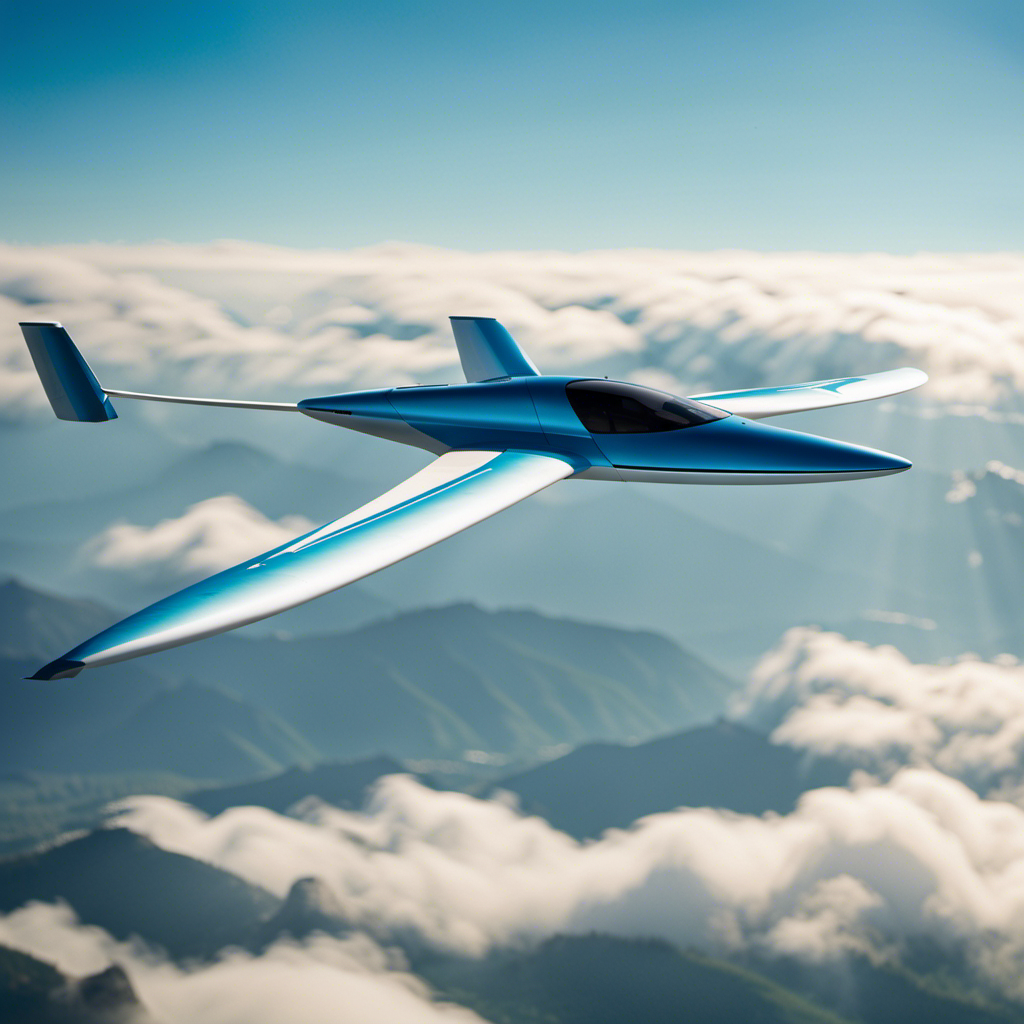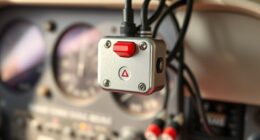As a hang glider pilot, I have always been fascinated by the intricate design and mechanics of our wings. An often overlooked but crucial component is the wing area, which greatly affects our flight performance.
In this article, we’ll delve into the world of wing area, exploring its significance, calculation methods, and its influence on glide ratio.
Join me on this journey as we unravel the mysteries behind this vital attribute and discover its impact on our hang gliding adventures.
Key Takeaways
- Wing area determines the flight performance of a hang glider.
- Larger wing area allows for more lift at slower speeds, while smaller wing area requires higher speeds for lift.
- Wing area is measured in square feet or square meters and is the total surface area of the wings.
- Wing area optimization is crucial for improving glide ratios and finding the right balance between lift, drag, and responsiveness.
The Basics of Hang Glider Wings
To understand the basics of hang glider wings, you need to know that their wing area plays a crucial role in their performance. The wing area refers to the total surface area of the wings. It is an important parameter that impacts various aspects of the glider’s flight characteristics. The wing area directly influences the lift generated by the wings, as well as the amount of drag experienced during flight.
One key factor affected by the wing area is the understanding of wing span. Wing span refers to the distance between the wingtips. A larger wing area generally corresponds to a longer wing span, which increases the overall lift capacity of the glider. This allows for better performance in terms of gliding distance and ability to stay airborne for longer periods.
Another aspect related to the wing area is wing flexion. Wing flexion refers to the bending or deformation of the wings under aerodynamic forces. A larger wing area can provide more structural support, reducing the amount of flexion experienced by the wings during flight. This is crucial for maintaining stability and control during maneuvers.
Understanding the relationship between wing span, wing flexion, and wing area is essential for comprehending the overall performance of hang glider wings. Now that we have explored the basics of hang glider wings, let’s delve into understanding wing area and its importance in further detail.
Understanding Wing Area and Its Importance
Understanding the importance of wing area is crucial when it comes to flying a hang glider. Many people have misconceptions about wing area and its significance in determining the performance of a glider. Let me explain it in technical terms.
Wing area refers to the total surface area of the wings. It plays a vital role in determining the lift generated by the glider. A larger wing area allows for more lift to be produced, enabling the glider to stay in the air at slower speeds. On the other hand, a smaller wing area requires higher speeds to generate the necessary lift.
To give you a better understanding, here is a table that compares the wing area of different hang glider models:
| Hang Glider Model | Wing Area (square feet) |
|---|---|
| Model A | 180 |
| Model B | 210 |
| Model C | 250 |
| Model D | 300 |
| Model E | 350 |
As you can see, the wing area increases as we move from Model A to Model E. This means that Model E will generate more lift and allow for slower flying speeds compared to Model A.
Now that we have established the significance of wing area, let’s delve into the relationship between wing area and glide ratio.
The Relationship between Wing Area and Glide Ratio
When it comes to glide ratio, the larger the wingspan, the better. This is because a larger wingspan allows for a greater wing area, which plays a crucial role in lift generation. Understanding wing area measurements and its relationship with lift is essential for optimizing the performance of a hang glider.
Wing area refers to the total surface area of the wings. It is measured in square feet or square meters and is determined by multiplying the wingspan by the average chord length. The chord length is the distance between the leading and trailing edges of the wing.
The relationship between wing area and lift is straightforward. The larger the wing area, the more air the wings can interact with, resulting in increased lift. This is due to the increased surface area available for air to flow over, creating a greater pressure differential between the upper and lower surfaces of the wings.
Factors affecting wing area include the design of the wing, the number of wings, and the shape of the wing. These factors can impact the overall lift and performance of the hang glider. By optimizing the wing area and considering these factors, pilots can achieve better glide ratios and enhance their flying experience.
Factors Affecting Wing Area
When it comes to hang gliders, the wing shape and design play a crucial role in their overall performance. The shape and design of the wing determine factors such as lift, drag, and stability.
Another important factor to consider is the aspect ratio, which is the ratio of the wing’s span to its average chord length. A higher aspect ratio typically results in greater lift and improved glide performance.
Additionally, wing loading, which is the weight of the aircraft divided by the wing area, also affects the performance of a hang glider. Higher wing loading can result in faster flight speeds but may also decrease maneuverability.
Wing Shape and Design
To maximize lift and stability, you’ll want to consider the shape and design of the wing when choosing a hang glider. The wing area optimization plays a crucial role in the performance of the glider.
A larger wing area allows for increased lift, which can be advantageous for beginners or in light wind conditions. However, there are trade-offs to consider. A larger wing area can also increase drag and make the glider less responsive.
On the other hand, a smaller wing area reduces drag and improves maneuverability, but it may compromise lift and stability. Finding the right balance between wing area and performance is essential.
Now, let’s delve into another important aspect of hang glider design: the aspect ratio.
Aspect Ratio
The aspect ratio of a hang glider affects its performance and maneuverability. The aspect ratio is the ratio of the wingspan to the average chord length. A higher aspect ratio means a longer, narrower wing, while a lower aspect ratio means a shorter, wider wing.
Hang gliders with higher aspect ratios generally have better glide performance and higher aerodynamic efficiency. This is because the longer, narrower wings create less drag and generate more lift. The increased lift-to-drag ratio allows the hang glider to maintain forward speed and stay airborne for longer periods of time.
Transitioning to the next section, wing loading also plays a crucial role in hang glider performance and stability.
Wing Loading
Understanding wing loading is important because it directly impacts your hang glider’s stability and maneuverability. Wing loading refers to the weight of the hang glider divided by the wing area. It is a crucial factor in determining the performance of your glider.
A high wing loading means that the weight is distributed over a smaller wing area, resulting in a higher pressure on the wings. This can lead to reduced lift and decreased maneuverability. On the other hand, a low wing loading means that the weight is spread out over a larger wing area, resulting in less pressure on the wings and improved lift.
To calculate wing loading, you need to know the weight of the hang glider and the wing span. Once you have determined the wing loading, you can move on to calculating the wing area.
Calculating Wing Area
When it comes to calculating wing area, there are several methods and formulas that can be used. These methods often involve measuring various dimensions of the wing, such as span and chord length, and using these measurements to calculate the total area.
Accurate measurements are crucial in this process, as even small errors can lead to significant discrepancies in the final calculation. Therefore, it is important to ensure that measurements are taken carefully and precisely to obtain accurate results.
Methods and Formulas
One way to calculate the wing area of a hang glider is by using the trapezoid formula. This formula takes into account the length of the wing and the average width at two different points. By plugging in these values, you can determine the wing area accurately.
Here are three advantages of having a larger wing area on a hang glider:
-
Improved lift: With a larger wing area, the hang glider can generate more lift, allowing for better overall performance and longer flight durations.
-
Increased stability: A larger wing area provides more surface area for the air to interact with, resulting in improved stability and control during flight.
-
Enhanced maneuverability: The added wing area allows for greater maneuverability, making it easier to perform turns, loops, and other aerobatic maneuvers.
Calculating the wing aspect and understanding the advantages of a larger wing area are crucial for designing and optimizing hang gliders. However, accurate measurements are essential to ensure the success and safety of the final product.
Importance of Accurate Measurements
Accurate measurements are crucial for ensuring the success and safety of the final design and optimization of a hang glider. The importance of accurate measurements cannot be overstated, as they provide the foundation for precise calculations and accurate predictions of the glider’s performance.
By obtaining precise measurements of various parameters such as wing length, chord length, and wingtip angle, designers can calculate the wing area with utmost accuracy. This allows them to optimize the glider’s performance by adjusting other design parameters accordingly.
Precise calculations based on accurate measurements enable the designer to determine the optimal wing area, leading to improved lift and reduced drag. The impact of wing area on performance is significant, as it directly affects the glider’s stability, maneuverability, and overall efficiency.
With accurate measurements and precise calculations, designers can achieve optimal wing area and deliver a hang glider that excels in all aspects of performance.
The Impact of Wing Area on Performance
To improve your hang glider’s performance, you should consider how wing area affects it. The wing area plays a crucial role in determining the stability and maneuverability of your hang glider. Here are some key points to help you understand the impact of wing area on performance:
-
Stability:
-
Increased wing area provides more lift, resulting in greater stability during flight.
-
A larger wing area helps to counteract turbulence and gusts, making the glider less prone to sudden changes in direction.
-
With a larger wing area, the center of pressure is more spread out, enhancing stability and reducing the chances of tip stalls.
-
Maneuverability:
-
Smaller wing areas offer higher maneuverability due to reduced drag and increased responsiveness.
-
Decreased wing area allows for quicker turns and better control, making it ideal for experienced pilots.
-
However, it’s important to note that smaller wing areas may also compromise stability in certain flying conditions.
Considering the impact of wing area on stability and maneuverability is essential for optimizing your hang glider’s performance. Now, let’s explore the role of wing area in different flying conditions.
The Role of Wing Area in Different Flying Conditions
In my previous discussion, I highlighted how wing area influences the overall capabilities of a hang glider. Let’s delve deeper into the role of wing area in different flying conditions and its effect on maneuverability.
In calm and stable weather, a larger wing area provides more lift, allowing the glider to maintain altitude with ease. On the other hand, in turbulent or gusty conditions, a smaller wing area can offer better control and maneuverability, reducing susceptibility to sudden changes in airflow.
The wing area directly affects the maneuverability of a hang glider. A larger wing area provides more lift but also increases weight and drag. This can make executing precise maneuvers difficult, especially in tight spaces or during aerobatic maneuvers. Conversely, a smaller wing area reduces weight and drag, enhancing agility and responsiveness for performing intricate maneuvers with greater ease.
Understanding the role of wing area in different flying conditions and its impact on maneuverability is vital for hang glider pilots. By selecting the appropriate wing area for prevailing weather conditions, pilots can optimize performance and ensure a safe and enjoyable flying experience.
Now, let’s explore the crucial relationship between wing area and safety considerations.
Wing Area and Safety Considerations
Safety considerations are crucial when determining the appropriate size of the wings on a hang glider. This is because the wing area directly affects the safety and performance of the glider. Here are some key points to consider:
-
Safety regulations: Safety regulations set by governing bodies dictate the minimum and maximum wing area limits for hang gliders. These regulations ensure that the gliders are designed to withstand various flight conditions and minimize the risk of accidents.
-
Load capacity: The wing area needs to be sufficient to support the weight of the pilot and any additional equipment or payload. This ensures that the glider can maintain stability and control during flight.
-
Stability: A larger wing area provides greater stability by increasing the glider’s resistance to pitch and roll movements. It helps the glider maintain a level flight path and reduces the risk of stalling or spinning.
-
Maneuverability: While safety is paramount, the wing area should also allow for adequate maneuverability. A smaller wing area enables quicker response to control inputs and allows the pilot to perform tighter turns and maneuvers.
-
Aerodynamic efficiency: The wing area should be optimized for aerodynamic efficiency. This means finding the right balance between lift and drag to maximize performance and glide ratio.
Considering these factors, the appropriate wing area for a hang glider must meet safety regulations, provide sufficient load capacity and stability, enable maneuverability, and optimize aerodynamic efficiency. This ensures a safe and enjoyable flying experience for pilots.
In the subsequent section, we will explore the innovations and advances in wing area technology that have further improved hang glider performance.
Innovations and Advances in Wing Area Technology
One major advancement in wing technology is the use of carbon fiber materials, which have significantly improved the performance of hang gliders. Carbon fiber is a lightweight, yet strong material that allows for greater flexibility and durability in wing design. This has led to advances in wing shape and wing area optimization, resulting in improved aerodynamics and overall flight performance.
To further illustrate the importance of wing area optimization, let’s take a look at the following table:
| Wing Area (square feet) | Glide Ratio | Lift-to-Drag Ratio |
|---|---|---|
| 150 | 10:1 | 20:1 |
| 175 | 12:1 | 22:1 |
| 200 | 14:1 | 24:1 |
| 225 | 16:1 | 26:1 |
| 250 | 18:1 | 28:1 |
As we can see from the table, increasing the wing area allows for higher glide ratios and lift-to-drag ratios. This means that a hang glider with a larger wing area will be more efficient and have better performance in terms of gliding and lift.
Tips for Choosing the Right Wing Area for Your Hang Glider
To choose the right wing size for your hang glider, consider factors such as your weight, experience level, and desired flight performance. Choosing the optimal wing size is crucial for optimizing performance and achieving the best possible flight experience.
When it comes to choosing wing size, your weight plays a significant role. Heavier pilots require larger wings to generate enough lift to support their weight. On the other hand, lighter pilots can benefit from smaller wings, as they require less lift to achieve flight.
Experience level is another important factor to consider. Beginners may find it easier to handle smaller wings, as they provide more stability and are less sensitive to pilot inputs. As you gain experience and develop your skills, you can gradually move on to larger wings, which offer more maneuverability and speed.
Your desired flight performance also influences wing size selection. If you enjoy leisurely, relaxed flights, a larger wing with a higher aspect ratio may be suitable. However, if you are looking for a more dynamic and fast-paced flying experience, a smaller wing with a lower aspect ratio would be more appropriate.
Frequently Asked Questions
What are the different types of hang glider wings available?
There are several types of hang glider wings available, each with their own advantages and disadvantages. Some common types include flex wings, rigid wings, and delta wings. Flex wings offer ease of transport, but may lack stability. Rigid wings provide better performance but are heavier, while delta wings offer improved maneuverability but can be challenging to control.
How does the wing area affect the handling and maneuverability of a hang glider?
The wing area of a hang glider greatly affects its handling and maneuverability. A larger wing area provides more lift and stability, increasing aerodynamic efficiency. However, safety considerations must be taken into account to prevent excessive wing loading and potential instability.
Are there any regulations or guidelines regarding the minimum or maximum wing area for hang gliders?
There are regulations and guidelines regarding wing area for hang gliders, with minimum and maximum restrictions. These restrictions are in place to ensure safety and performance implications, taking into account aerodynamics considerations.
Can the wing area be adjusted or modified to improve the performance of a hang glider?
Adjusting the wing area of a hang glider can improve its performance and glider efficiency. By modifying the wing area, pilots can optimize lift and drag characteristics, leading to better control and maneuverability.
Are there any limitations or drawbacks to consider when choosing a hang glider with a larger wing area?
When choosing a hang glider with a larger wing area, it is crucial to consider the limitations and drawbacks. These may include increased weight and slower maneuverability, which can affect overall performance and handling.
Conclusion
In conclusion, it is evident that the size of the wing area plays a crucial role in determining the performance and safety of hang gliders. By understanding the relationship between wing area and glide ratio, pilots can make informed decisions when choosing the right wing area for their gliders. Factors such as weight, speed, and flying conditions should also be considered. Advancements in wing area technology continue to improve the efficiency and maneuverability of hang gliders, ensuring a better flying experience for enthusiasts.
With a heart that soars as high as the skies, Aria, affectionately known as “Skylark,” is the driving force behind Soaring Skyways. Her journey into the gliding world began as a young dreamer gazing up at the soaring birds, yearning to experience the weightlessness and freedom they embodied. With years of experience both in the cockpit and behind the scenes, Aria’s commitment to the gliding community is unwavering.
